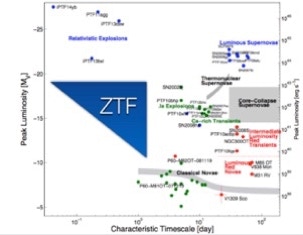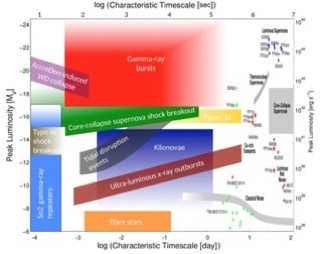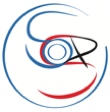Scientific topics
In the near future, we will enter the golden age of time-domain astronomy having in place deep ground-based optical surveys (PanSTARRS, Dark Energy Survey, La Silla Quest, SkyMapper, Zwicky Transient Factory, Large Synoptic Survey Telescope, etc.), space-based optical surveys (Gaia and Euclid), high-energy instruments (Swift, Fermi, INTEGRAL, MAXI and SVOM), radio surveys (LOFAR, MeerKAT, SKA), Gravitational Wave (GW) experiments (A-Virgo, A-Ligo), neutrino experiments (KM3Net, ANTARES), all calling for a rapid follow-up and characterisation (and distance determination) of the detected transients. A bibliographic search showed that among astronomical papers published on Nature in the 2005-2014 time frame, ~40% of them are on transient objects/events. The discovery space in this research field is potentially immense, including virtually all astronomy disciplines. A dedicated suitable spectroscopic facility able to exploit the science of these transients is lacking, resulting in severe science “dissipation”.
The science case is then very broad, given the versatility of such an instrument and the intrinsic variability of the sky at all wavelengths. It ranges from moving minor bodies in the solar system, to bursting young stellar objects, cataclysmic variables and X-ray binary transients in our Galaxy, supernovae and tidal disruption events in the local Universe, up to gamma-ray bursts in the very distant and young Universe, basically encompassing all distance scales and astronomy branches. Although the focus is on transients and variables, there is anyway a wide range of astrophysical targets and science topics that could benefit from an instrument with the capability of SOXS at the NTT.
A spectroscopic facility to follow-up transient sources is a unique tool to provide a service to the community at large and to do great science. Time-domain optical surveys are revolutionising the optical astronomy providing insight in basically all areas. Transients discovered by current surveys have limiting magnitudes R~20, that are well suited to be followed-up by a 4 m-class telescope. High-energy missions (e.g. Swift, INTEGRAL, Fermi) are detecting in real-time transients sources calling for a fast follow-up. SOXS will be a key instrument to provide the spectroscopic partner to any kind of transient survey. The experience of the Swift high-energy mission in the study of the X-ray sky is enlightening. A fraction of the Swift observing time is fully open to Target of Opportunity (ToO) observations from the community. A great use of this time has been done since now, considerably contributing to the success of the Swift mission. In the optical, especially concerning the spectroscopic domain, a similar possibility of fast triggering short observations is lacking (unless very highly ranked pre-approved programs adopting a Rapid Response Mode).
We are testing observing, software, triggering operations on the NTT now with the ePESSTO (a follow-up of the successful PESSTO legacy survey) large program with a view to SOXS operations in the era of ZTF, LSST, Pan-STARRS2.



Figure 1: Left: V-band magnitude as a function of characteristic decay/variability timescale for luminous optical transients and variables (ZTF collaboration). Right: The absolute optical magnitude (left labels and red colours) or X-ray luminosity (right labels and in grey) is plotted vs. the variability time (Jonker et al. 2012; Cook et al. 2016).
